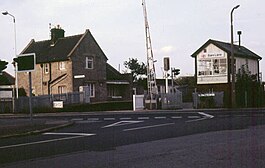Bare Lane railway station
| Bare Lane |
|
|---|---|
 |
|
| Location | |
| Place | Bare |
| Local authority | Lancaster |
| Coordinates | 54°04′30″N 2°50′10″W / 54.075°N 2.836°WCoordinates: 54°04′30″N 2°50′10″W / 54.075°N 2.836°W |
| Grid reference | SD454646 |
| Operations | |
| Station code | BAR |
| Managed by | Northern |
| Number of platforms | 2 |
| DfT category | F1 |
| Live arrivals/departures, station information and onward connections from National Rail Enquiries |
|
| Annual rail passenger usage* | |
| 2011/12 |
|
| 2012/13 |
|
| 2013/14 |
|
| 2014/15 |
|
| 2015/16 |
|
| History | |
| Original company | London and North Western Railway |
| Post-grouping | London Midland and Scottish Railway |
| 8 August 1864 | Opened as Poulton-le-Sands |
| 31 October 1864 | Renamed Bare Lane |
| National Rail – UK railway stations | |
| * Annual estimated passenger usage based on sales of tickets in stated financial year(s) which end or originate at Bare Lane from Office of Rail and Road statistics. Methodology may vary year on year. | |
|
|
|
Bare Lane railway station serves the village of Bare, which is a suburb of Morecambe in Lancashire, England. It is located on the Morecambe Branch Line from Lancaster to Heysham Port and was opened by the London and North Western Railway in 1864.
A level crossing with the public highway known as Bare Lane exists immediately to the west of the station, which until recently was controlled by the adjacent Bare Lane signal box, a fringe cabin to the Preston PSB Area. This box was closed on 8 December 2012, when the signalling equipment was renewed by Network Rail and control of the crossing switched to CCTV and transferred to Preston power box.
The old station building on the platform is now a private dwelling. It was auctioned to the public, and was featured on the BBC programme Homes Under the Hammer, a show about buildings which are auctioned to the public and redeveloped.
Although the station has two side platforms, the track layout through it is not the conventional double track used on most main & secondary routes, but two independent bi-directional single lines. Platform 1 serves the Up & Down Morecambe line (which is in effect a long siding all the way to the terminus), whilst platform 2 handles trains on what is now the Up & Down Heysham line. The latter is connected to the now-single track branch down to Heysham Port at Holt Bank Junction (just outside Morecambe station), with the junction points operated from a ground frame worked by the train crew. The two lines converge east of the station, but then immediately split into the single line curves toward Hest Bank and towards Lancaster; the former sees only limited use, whereas the latter was double track until 1988 and is used by the vast majority of trains on the route.
...
Wikipedia
